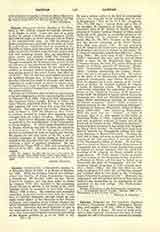

Cajetan, CONSTANTINO, a Benedictine savant, b. at Syracuse, Sicily, in 1560; d. at Rome, September 17, 1650. While his brothers, Ottavio and Alfonso, joined the Society of Jesus, Constantino became a Benedictine (October 29, 1586) at San Nicoll d’Arena in Catania, and was soon called to Rome by Clement VIII, who confided to the promising young scholar an edition of the works of St. Peter Damian, which he executed in four folio volumes (Rome, 1606 et step.). His constant and successful researches in Roman archives won him the friendship of Cardinal Baronius, through whom he was made titular Abbot of San Baronzio in the Diocese of Pistoia, and Custodian of the Vatican Library; the latter important office he held under four popes until his death. Baronius was much indebted to him in the composition of his “Annales Ecclesiastici”, and more than once praises Cajetan’s thorough knowledge of the Roman archives (e.g. ad an. 1002, n. 10).
He was a tireless worker in the field of ecclesiastical history; the long list of his writings may be seen in Ziegelbauer, “Hist. rei lit. 0. S. B.” (Augsburg, 1754, III, 380 sqq.). Among them are a life of the liturgist, St. Amalarius of Trier (Rome, 1612), annotated lives of St. Isidore of Seville, St. Ildephonsus of Toledo, Cardinal Gregory of Ostia, notes on the life of St. Anselm, an annotated edition of the “Vita Gelasii II” by Pandolfo of Pisa (Murat., Script. Rer. It., III, 367), treatises on the primacy and the Roman episcopate of St. Peter (Roccaberti, Bibl. max. pontif., VII). He was persuaded that St. Gregory the Great was a genuine disciple of St. Benedict, and wrote in defense of this thesis “De S. Gregorii monachatu benedictino libri duo” (Salzburg, 1620). The authorship of the “Imitation of Christ” interested him also, and he several times broke a lance for the Benedictine Jean Gersen [” Joannes Gersen, De Imit. Xti, acted. Defensio pro Gersen et methodo practices IV librorum” (Rome, 1616); “Concertatio, Apologetica responsio” (Rome, 1618); “Libellus apologeticus pro Gersen” (Rome, 1644), the latter two against Rosweyde]. His ador for the glory of the Benedictine Order troubled his judgment occasionally, says Father Hurter, e.g. when he claimed for it such persons as St. Columbanus of Bobbio, St. Thomas Aquinas, St. Francis of Assisi, St. Ignatius Loyola. He inaugurated the controversy concerning the authorship of the work known as the “Spiritual Exercises of St. Ignatius” by his book “De religiose S. Ignatii, sive S. Enneconis fundatoris soc. Jesu per Benedictinos institutione, deque libello exercitiorum ejusdem ab Exercitatorio Cisnerii desumpto” (Venice, 1641), in which he claimed priority for the Exercitatorium Spirituale” of Garcias de Cisneros, Benedictine Abbot of Montferrat (1455-1510). (See Spiritual Exercises of Saint Ignatius.) Both this work and the “Achates”, or reply of Giovanni Rho, S.J., were placed on the Index of Forbidden Books in 1646. Cajetan was an intelligent and munificent collector of books, and at his death left his fortune to the “Bibliotheca Aniciana”, founded by him in honor of the family of St. Gregory the Great (Gens Anicia); the books have since been divided between the Propaganda Library and that of the Sapienza, or Roman University. To many his chief title to fame will seem to rest on his claim to be considered the first promoter, if not the founder, of the Propaganda College at Rome. He had long hoped to found at Rome a Collegium Gregorianum de propaganda fide, in which young Benedictines might be trained for foreign missions, after the spirit and teachings of St. Gregory the Great, Apostle of the Anglo-Saxons. He really opened a house of studies for this purpose in the monastery of San Benedetto in Piscinula at Rome, and this may be looked on as historically the germ of Propaganda: (Cf. his “De erectione collegii Gregoriani in Urbe epistola encyclica”, Rome, 1622.) His idea was taken up seriously by Gregory XV (1621-23), and by him enlarged and modified until it took shape as the “Collegium [later Urbanum] de propaganda fide”. However, the enlightened zeal and pioneer labors of Dom Cajetan received due recognition by his nomination as first consultor of the new college. (See College of Propaganda).
THOMAS J. SHAHAN

